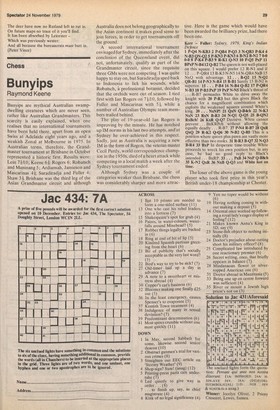Bunyips
Raymond Keene
Bunyips are mythical Australian swampdwelling creatures which are never seen, rather like Australian Grandmasters. This scarcity is easily explained, when one realises that no international tournaments have been held there, apart from an open Swiss at Adelaide eight years ago, and a Weakish Zonal at Melbourne in 1975. In Australian terms, therefore, the Grandmaster tournament at Brisbane in October represented a historic first. Results were: Lein 7i/10; Keene 64; Rogers 6; Robatsch and Maninang 5; Ardiansah, Jamieson and Mascarinas Suradiradja and Fuller 4; Shaw 3 Brisbane was the third leg of the Asian Grandmaster circuit and although Australia does not belong geographically to the Asian continent it makes good sense to join forces, in order to get tournaments off the ground.
A second international tournament envisaged for Sydney, immediately after the conclusion of the Queensland event, did not, unfortunately, qualify as part of the Grandmaster circuit, since the requisite three GMs were not competing. I was quite happy to stay on, but Suradiradja sped back to Indonesia to lick his wounds, while Robatsch, a professional botanist, decided that the orchids were out of season. I tied first with Ian Rogers on 7i/10, followed by Fuller and Mascarinas with 5 while a number of Australian Olympic team members trailed behind.
The play of 19-year-old Ian Rogers is improving by the minute. He has notched up IM norms in his last two attempts, and at Sydney he over-achieved in this respect. Sadly, just as Australia is acquiring a new 1M in the form of Rogers, the veteran master Cecil Purdy, world correspondence champion in the 1950s, died of a heart attack while competing in a local match a week after the Sydney tournament ended, Although Sydney was a couple of categories weaker than Brisbane, the chess was considerably sharper and more attrac tive. Here is the game which would have been awarded the brilliancy prize, had there been one.
Kerr — Fuller: Sydney, 1979, King's Indian Defence P-Q4 N-KB3 2 P.QB4 P-Q3 3 N-QB3 P-K4 4 N-B3 ON-Q2 5 P-KN3 P-KN3 6 B-N2 B-N2 70-0 0-0 8 P-K4 P-B3 9 R-K1 Q-N3 10 P-Q5 PxP 11 BPI& N-B4 12 Q-B2 The queen is not well-placed on this square. I would prefer 12 R-N1 and if '12. . . P-QR4 13 B-K3 N-N5 14 N-QR4 NxB 15 NxQ with advantage. 12. B-Q2 13 N-Q2 QR-B1 14 P-N3 N-R4 15 B-111 Surely 15 B-N2 is superior. 15 . . P-04 16 N-B4 Q-B2 17 P-QR4 N-B3 18 P-B3 Pxr 19 PP N-N5 Black's threat of
R-B7 persuades White to drive away the knight with 20 P-R3 but this gives Black the chance for a magnificent combination which exploits the weakened squares around White's king. 20. . . NxNP! 21 Qxlsi Q-B4ch 22 N-K3 NxN 23 MN B-R3 24 N-Q1 Q-Q5 25 B-QN2 Rxlich! 26 KxR Q-Q7 Decisive. White cannot prevent .. . BxKRPch without allowing the equally deadly. . . R-B7. 27 P-N4 R-B7 28 QxR QxQ 29 R-K2 Q-Q6 30 N-B2 Q-B5 This is a position where queen plus pawn are vastly more effective than two rooks. 31 R-R3 B-Q7 32 N-Q3 B-R4 33 BxP In desperate time-trouble White proceeds to wreck his own position but, in any case, he had no good reply to Black's intended BxRP. 33. . . PxB 34 NxP Q-Bfich time.
The QxR 36 NxB Q-Q3 and White lost on The loser of the above game is the young player who took first prize in this year's British under-18 championship at Chester.


































 Previous page
Previous page